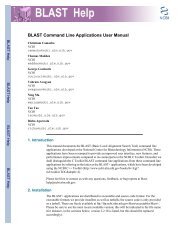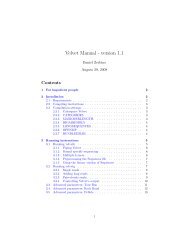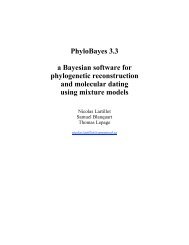PAUP* 4.0 Beta: Command Reference --Draft Version 3--
PAUP* 4.0 Beta: Command Reference --Draft Version 3--
PAUP* 4.0 Beta: Command Reference --Draft Version 3--
You also want an ePaper? Increase the reach of your titles
YUMPU automatically turns print PDFs into web optimized ePapers that Google loves.
<strong>Command</strong>s used in the ASSUMPTIONS Block<strong>Command</strong> <strong>Reference</strong>OPTIONSThis command houses a number of disparate subcommands. They are all ofthe form subcommand = option.DEFTYPE = type-nameThis specifies the default character type for parsimony analyses.Whenever a character's type is not explicitly stated, its type is takento be the default type. The default DEFTYPE is UNORD , but may bechanged to one of the following: ORD, UNORD, DOLLO, DOLLO.UP,DOLLO.DN, IRREV, IRREV.UP, or IRREV.DN.POLYTCOUNT = { MINSTEPS | MAXSTEPS }This option specifies whether polytomies are treated as "hard" or"soft" (see Maddison (1989)) when counting the number of stepsrequired by a character and when reconstructing ancestral states.<strong>PAUP*</strong> currently supports only POLYTCOUNT = MAXSTEPS ("hard"polytomies), and will ignore the POLYTCOUNT specification.GAPMODE = { MISSING | NEWSTATE | INDEL }Specifies how gaps are to be treated. GAPMODE = MISSING designatesgaps to be treated in the same way as missing data; GAPMODE =NEWSTATE specifies that gaps are to be treated as an additional state(for DNA/RNA data, as a fifth base).USERTYPE***** Give the predefined character types here. The USERTYPE commanddefines a character transformation type, as used in parsimony analysis todesignate the cost of changes between states. USERTYPES must be definedbefore they are referred to in any TYPESET. Character-type-description mustfollow the rules for character-state tree or stepmatrix description.The STEPMATRIX format is as follows:usertype mymatrix (stepmatrix)=ns s s s. k k kk . k kk k . kk k k .;where n is the number of rows and columns in the step matrix, the s's arestate symbols, and the k's are the cost for going between states. n can takeany value _ 2. Diagonal elements may be listed as periods. If a change is tobe prohibited, then one enters an "i" for infinity. Typically, the state symbolswill be in sequence, but they need not be. The following matrices assignvalues identically:20 February, 2002 <strong>PAUP*</strong> <strong>4.0</strong> beta documentation





